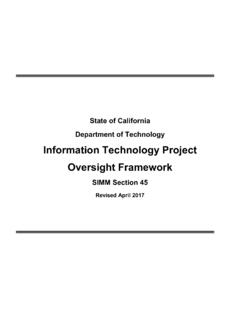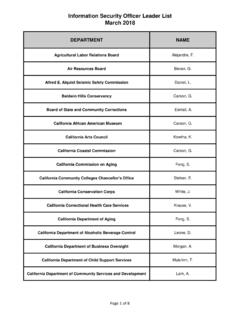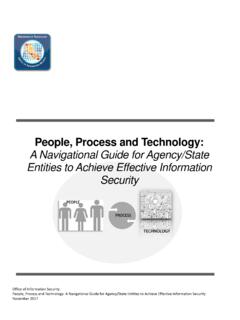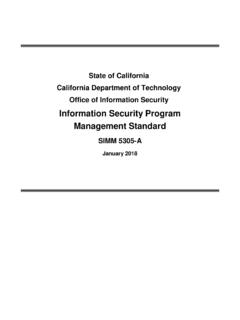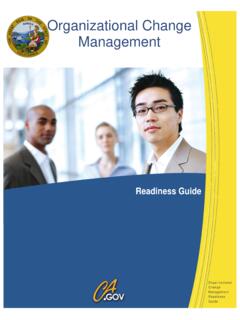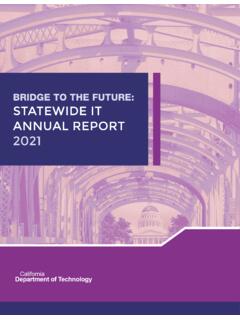Transcription of SIMM 5360-A Telework and Remote Access Security ... - CDT
1 State of California California Department of Technology Office of Information Security Telework and Remote Access Security Standard SIMM 5360-A October 2018 REVISION HISTORY REVISION DATE OF RELEASE OWNER SUMMARY OF CHANGES Initial Release December 2010 California Information Security Office (CISO) Minor Update September 2013 CISO SIMM number change Minor Update January 2018 Office of Information Security (OIS) Office name change Update October 2018 OIS Revise to requireweb-based connection to utilize two-factor authentication. Office of Information Security Telework and Remote Access Secur ity Standard SIMM 5360-A October 2018 Table of Contents AGENCY HEAD REQUIREMENTS.
2 3 Training of Telework and Remote Access Users .. 3 AGENCY MANAGEMENT Identify the Needs of Telework Users .. 3 AGENCY IT ADMINISTRATOR REQUIREMENTS .. 4 Maintain Software Updates .. 4 Limiting Telework User Privileges .. 4 Validating Control 4 Telework USER State-owned Information Assets to be Used for Network-Level 5 Web-based Secure Connections .. 5 Maintaining Security of Information Assets Used for Telework .. 5 Protection from Unauthorized Physical Access ..6 STANDARDS FOR EXCEPTIONS WHEN A PERSONALLY-OWNEDINFORMATION ASSET IS USED TOTELEWORK ..6 Exception and Risk Approval Process .. 6 Additional Training Requirements .. 7 User Account Passwords .. 7 Networking Attack Maintain Software Updates .. 7 Secure Application Configurations .. 8 Remote Access SoftwareConfiguration ..9 Security Maintenance and 9 RESTRICTIONS AND Security WITH USE OF THIRD PARTY DEVICES.
3 10 SECURING PERSONAL Securing Wired Personal Networks .. 10 Securing Wireless Personal Networks .. 11 Office of Informati on Security Telework and Remote Access Secur ity Standar d SIMM 5360-A October 2018 Telework AND Remote Access Security STANDARD APPLICABILITY This standard is not to be construed as either replacing or superseding any other applicable statewide, federal or private industry Security policy, standard or requirement including, but not limited to.
4 State Administrative Manual (SAM) Section 5100, and SAM Section 5300. This standard applies to Telework and Remote Access users1 who have Access to California State IT infrastructure and information assets through public networks. In addition totelework users, this standard is applicable to Security , system, and network engineers and administrators, as well as computer Security program managers, w ho are responsible for the technical aspects of preparing, operating, and securing Remote Access solutions and Telework client devices, and state entity heads and program managers responsible f or the overall Security of i nformation assets with in their agencies. The material in this standard is technically oriented, and it is assumed that readers have at least a basic understanding of Remote Access , networking, network Security , and system Security .
5 Those not having this level of understanding should consult their agency Chief Information Officer and Information Security Officers f or assistance. DEFINITIONS2 Agency When used lower case (agency), refers to any office, department, board, bureau, commission or other organizational entit y within state government. When capitalized(Agency), the term refers to one of the state's super agencies; such as the State and Consumer Services Agency or the Health and Human Services Agency (see SAM Section definitions). Direct Application Access Architecture A high-level Remote Access architecture th at allows teleworkers to Access an individual application directly, without using Remote Access software. Information Assets All categories of information (confidential, personal, sensitive, or public), all forms of information assets (paper or electronic), information technology facilities, equipment and software owned or leased by state agencies.
6 (See SAM Section definitions; Condensed). IT Administrators The agency s IT staff such as those individuals responsible f or support and Security of the ITinfrastructure. IT Infrastructure An agency s information technology platform for the support of agency programs and management. Included in the infrastructure are equipment, software, communication networks. (See SAM Section definitions; Adapted.) Mobile Computing Device Portable-computing devices t hat can connect by cable, telephone wire, wireless transmission, or via any Internet connection to an agency's IT infrastructure and/or data systems. (See SAM Section ). 1 For the remainder of this document teleworker, Telework user and Remote Access user areinterchangeable. 2 The National Institute of Standards and Technology (NIST) Special Publication 800-46, Appendix A Glossary is the source of Remote architecture definitions.
7 1 Office of Informati on Security October 2018 Telework and Remote Access Secur ity Standar d SIMM 5360-A Multi-homed connection A host connected to two or more networks or having two or more network addresses. For example, a computer may be connected to a serial line and a LAN or to multiple LANs.
8 Network-level Connection The connection provides Access to a state private network through a tunneling or a Remote desktop Access architecture and the software and data that reside on the internal information assets. Portal Architecture A high-level Remote Access architecture that is based on a server that offers teleworkers Access to one or more applications through a single, centralized interface. Remote Access - The connection of an information asset from an off -site location to an information asset on state IT infrastructure. Remote Desktop Access Architecture A high-level Remote Access architecture that gives a teleworker the ability to remotely control a particular desktop computer at the organization, most often the computer assigned to the user that resides at the organization s office from a Telework device. Smartphone A mobile computing device that provides advanced computing capability and connectivity, and runs a complete operating system and platform for application developers and users to install and run more advanced applications.
9 Split Tunneling The process of allowing a Remote VPN user to Access a public network, most commonly the Internet, at the same time that the user is allowed to Access resources on the VPN. A disadvantage of this method is that it essentially renders the VPN vulnerable to attack as it is accessible through the public, non-secure network. Strong password A minimum of eight characters using a combination of upper and lowercase letters, numbers and specialcharacters. Telework An arrangement in which an employee regularly performs officially assigned duties at home or an alternate work site. Tunneling Architecture A high-level Remote Access architecture that provides a secure tunnel between a Telework device and a tunneling server through which application traffic may pass. Tunnels use cryptography to protect the confidentiality and integrity of thetransmitted information between client device and the VPNgateway Two-factor authentication Authentication based on two of the following: something you know ( , password), something you have ( , token or smartcard), or something you are ( ,a biometric).
10 Virtual Private Network (VPN) A virtual network, built on top of existing physical networks, that provides a secure communications tunnel for data and other information transmitted between networks. Web-based Connection the connection provides Access to one or more applications through a single centralized interface through a direct application Access or portal architecture (typically a web-browser to a portal server located within the demilitarized zone [DMZ]). This type of 2 Office of Informati on Security October 2018 Telework and Remote Access Secur ity Standar d SIMM 5360-A connection creates an area that serves as a boundary between two or more networks and isolates the information asset from the internal private network.
